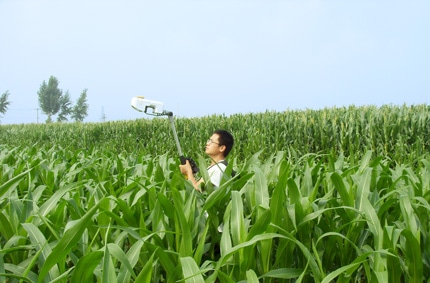Jan 17 2019
Even a good thing can turn harmful if it is taken in excessive amounts. That is indeed true in the case of nitrogen fertilizers. Crops do not grow well without adequate nitrogen, and as a result, yields are reduced considerably.
 A student uses the GreenSeeker active canopy sensor to collect canopy reflectance data. The collected data will help determine the crop's nitrogen status. (Image credit: Guohui Feng)
A student uses the GreenSeeker active canopy sensor to collect canopy reflectance data. The collected data will help determine the crop's nitrogen status. (Image credit: Guohui Feng)
By contrast, the excessive use of nitrogen fertilizers could be harmful to the environment. Nitrogen can pollute aquatic ecosystems when it enters the watershed. Furthermore, surplus nitrogen can be converted by microbes into nitrous oxide—one of the greenhouse gases responsible for climate change.
Managing nitrogen is vital for global food security. It is also crucial for reducing pollution and climate change.
Yuxin Miao, Agronomist, University of Minnesota
Miao and his team have been exploring ways to efficiently manage nitrogen in agriculture. They compared many methods and identified that one method, called active canopy sensor-based nitrogen management, is the most effective one.
Sensor-based nitrogen management involves the use of light sensors for the active monitoring of crop health and vitality. The sensors measure various wavelengths of light that come from leaves of crops. These measurements act as representatives of crop health.
The software in the sensors can calculate the amount of nitrogen required by the crops on the basis of field measurements. Farmers can apply optimal amounts of nitrogen to crops by using these data.
According to Miao, the objective is to “match nitrogen supply with crop nitrogen demand.” That enables crops to access nitrogen fertilizers precisely when it is most required, consequently maximizing yields.
When compared to other nitrogen management approaches, this method offers many advantages. “It reduced overall nitrogen fertilizer application,” stated Miao. “It also decreased nitrogen loss into the environment and lowered nitrous oxide emissions.”
Canopy sensor-based systems also have many other benefits.
Using sensors is fast and non-destructive. There are no additional costs beyond purchasing the sensors.
Yuxin Miao, Agronomist, University of Minnesota
In addition, environmental light does not have any effect on the latest sensor models. This suggests that growers can obtain an accurate measurement regardless of the weather, without the need to clear clouds.
In addition, it may also offer monetary benefits. “This technology can reduce the use of nitrogen fertilizers,” stated Miao. “Farmers can lower production costs and increase economic returns.”
Between 2008 and 2012, Miao and his teammates carried out field experiments to test various nitrogen management approaches. The study location was in the Hebei Province in northern China. The scientists tested various strategies on a winter wheat and summer corn rotation system.
A few of the other nitrogen management approaches tested by Miao also included the reduction of fertilizer use. However, all of them had shortcomings. For instance, one system needed the soil to be tested for nitrogen levels. “However, this system had labor, time, and cost limitations,” stated Miao.
Miao is currently striving to make advancements. A few of the new systems will be more appropriate for high-yield cropping systems, while others may be more efficient compared to the existing hand-held ones.
Miao expects that these sensor systems will reach worldwide. “This strategy of nitrogen management would work with major crops in many countries.”
However, Miao believes that it is not possible for farmers to do it alone. Researchers, farmers, and service providers will have to work jointly.
That can facilitate widespread adoption of this system, especially in developing countries.
Yuxin Miao, Agronomist, University of Minnesota
The results of the study were presented by Miao at the November 2018 meeting of the American Society of Agronomy and Crop Science Society of America in Baltimore, MD.